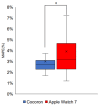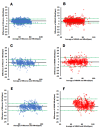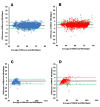Evaluation of Telemetric Single-Lead Cardiac Transmitter and Apple Watch for Heart Rate Monitoring: Implications for Heart Failure Management in Home Care
- PMID: 40196089
- PMCID: PMC11973402
- DOI: 10.7759/cureus.80232
Evaluation of Telemetric Single-Lead Cardiac Transmitter and Apple Watch for Heart Rate Monitoring: Implications for Heart Failure Management in Home Care
Abstract
Objective The study aimed to investigate the usefulness of a telemetric single-lead cardiac transmitter and the Apple Watch 7 (2021 version; Apple Inc., Cupertino, CA, USA) for monitoring heart rate during activity. Methods A total of 15 healthy male adults aged 24-39 years were included in this study. A wireless radio frequency electrocardiogram (RF-ECG) was used as a reference, and heart rate was measured simultaneously with the Cocoron telemetric single-lead electrocardiograph (Nipro, Osaka, Japan, NC-1BLE) and Apple Watch 7. The mean absolute error (MAE), mean absolute percentage error (MAPE), and intraclass correlation coefficient were calculated from the difference in heart rate between the RF-ECG-based wearable, Cocoron, and Apple Watch 7 at each measurement time point. Bland-Altman plots were generated. Results A two-way analysis of variance for the MAPE of heart rate for the Cocoron and Apple Watch 7 based on RF-ECG showed that the MAPE of the Cocoron was significantly lower than that of the Apple Watch 7 (p=0.013). This result suggests that the Cocoron provides more accurate heart rate measurements compared to the Apple Watch 7. The Bland-Altman plot revealed that the MAPE was 2.39%, 3.30%, and 3.27% for the Cocoron during supine, seated, and walking positions, respectively, and 2.26%, 3.71%, and 5.82% for the Apple Watch 7, with significantly higher values for walking compared to supine and seated. A tendency to overestimate the limits of agreement (LOA) was observed for a wider range of LOA, with the Apple Watch 7 showing a particularly large LOA upper limit of 12.02 during ambulation. This visually indicates a tendency to overestimate the heart rate during movement. This larger error is likely due to motion artifacts inherent in the wrist-based photoplethysmography (PPG) method used by the Apple Watch, which could compromise its usability in dynamic settings. Conclusions The Cocoron telemetric single-lead electrocardiograph transmitter measured heart rate with less error than the Apple Watch 7. During ambulation, the Apple Watch 7 had a larger error than the supine and seated positions, whereas the Cocoron had a smaller error. Since accurate and continuous heart rate monitoring is critical for the effective management of heart failure, these findings imply that devices with superior measurement accuracy, like the Cocoron, could improve clinical decision-making and patient outcomes. However, it is important to note that further studies involving heart failure patients are needed to confirm these implications in a clinical setting.
Keywords: apple watch; heart failure; heart rate determination; home health nursing; home medical care; wearable electronic devices.
Copyright © 2025, Imai et al.
Conflict of interest statement
Human subjects: Consent for treatment and open access publication was obtained or waived by all participants in this study. Kyoto Prefectural University of Medicine Ethics Committee issued approval ERB-E-519. Animal subjects: All authors have confirmed that this study did not involve animal subjects or tissue. Conflicts of interest: In compliance with the ICMJE uniform disclosure form, all authors declare the following: Payment/services info: All authors have declared that no financial support was received from any organization for the submitted work. Financial relationships: All authors have declared that they have no financial relationships at present or within the previous three years with any organizations that might have an interest in the submitted work. Other relationships: All authors have declared that there are no other relationships or activities that could appear to have influenced the submitted work.
Figures







Similar articles
-
Accuracy of Apple Watch Measurements for Heart Rate and Energy Expenditure in Patients With Cardiovascular Disease: Cross-Sectional Study.JMIR Mhealth Uhealth. 2019 Mar 19;7(3):e11889. doi: 10.2196/11889. JMIR Mhealth Uhealth. 2019. PMID: 30888332 Free PMC article.
-
Accuracy of Consumer Wearable Heart Rate Measurement During an Ecologically Valid 24-Hour Period: Intraindividual Validation Study.JMIR Mhealth Uhealth. 2019 Mar 11;7(3):e10828. doi: 10.2196/10828. JMIR Mhealth Uhealth. 2019. PMID: 30855232 Free PMC article.
-
The Feasibility and Reliability of Upper Arm-Worn Apple Watch Heart Rate Monitoring for Surgeons During Surgery: Observational Study.JMIR Hum Factors. 2023 Nov 1;10:e50891. doi: 10.2196/50891. JMIR Hum Factors. 2023. PMID: 37910162 Free PMC article.
-
Apple watch accuracy in monitoring health metrics: a systematic review and meta-analysis.Physiol Meas. 2025 Apr 17;46(4). doi: 10.1088/1361-6579/adca82. Physiol Meas. 2025. PMID: 40199339
-
The Apple Watch for Monitoring Mental Health-Related Physiological Symptoms: Literature Review.JMIR Ment Health. 2022 Sep 7;9(9):e37354. doi: 10.2196/37354. JMIR Ment Health. 2022. PMID: 36069848 Free PMC article. Review.
References
-
- Burden of heart failure and underlying causes in 195 countries and territories from 1990 to 2017. Bragazzi NL, Zhong W, Shu J, et al. Eur J Prev Cardiol. 2021;28:1682–1690. - PubMed
-
- 2021 ESC guidelines for the diagnosis and treatment of acute and chronic heart failure: developed by the task force for the diagnosis and treatment of acute and chronic heart failure of the European Society of Cardiology (ESC). With the special contribution of the Heart Failure Association (HFA) of the ESC. McDonagh TA, Metra M, Adamo M, et al. Eur J Heart Fail. 2022;24:4–131. - PubMed
-
- Clinical characteristics and outcomes of hospitalized patients with heart failure from the large-scale Japanese Registry of Acute Decompensated Heart Failure (JROADHF) Ide T, Kaku H, Matsushima S, et al. Circ J. 2021;85:1438–1450. - PubMed
-
- Impending epidemic: future projection of heart failure in Japan to the year 2055. Okura Y, Ramadan MM, Ohno Y, et al. Circ J. 2008;72:489–491. - PubMed
LinkOut - more resources
Full Text Sources
